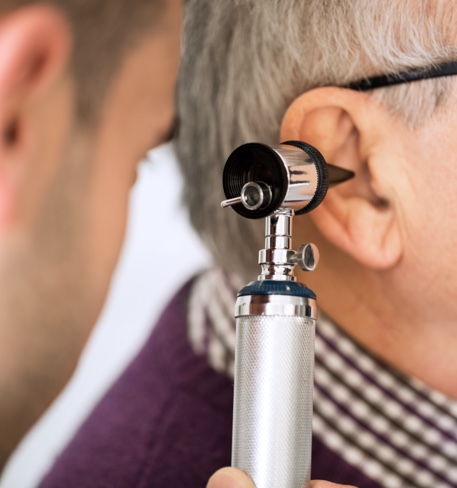
Middle Ear Infection in Adults & Children
The medical term for a middle ear infection in adults and children is Otitis Media. It’s diagnosed when the air-filled space that runs from the eardrum to the back of the throat – called the Eustachian Tube – becomes swollen or blocked with infected fluid.
If you suspect you’re experiencing Otitis Media, take our online hearing test or make a booking enquiry.
What are the main causes for the Otitis Media middle ear infection?
The swelling or blockage of the Eustachian Tube can be caused by viruses, allergies, fungi, bacterial infections and enlarged adenoids.
Most commonly, Otitis Media middle ear infections develop as a consequence of a cold, flu or similar upper respiratory infection in the throat that spreads into the Eustachian Tube.
Otitis Media is very common in children. It often disappears by itself in days, but sometimes may need treatment. Children aged 6-18 months are most prone to middle ear infection symptoms due to their narrow Eustachian Tubes. Adults can also suffer from Otitis Media, though it is less common.
Children with a heightened level of risk are those with a high frequency of nose and throat infections (especially those in childcare nurseries or creches where exposure to infection is more likely), they’re exposed to passive cigarette smoke, they have a cleft palate or have Down Syndrome.
What are the different types of Otitis Media?
Infections can affect the middle ear in several ways:
Acute Otitis Media (AOM)
This short-term middle ear infection comes on rapidly. It causes swelling and redness. Fluid and pus become trapped under the eardrum. The result is a high fever and severe pain emanating from the middle ear.
Otitis Media with Effusion (OME)
OME is longer-lasting, leaving the ear feeling “full” but without the sharp pain of AOM. It’s caused by a build-up of non-infectious fluid or mucus (ie. “effusion”) left in the middle ear canal after the initial infection has passed.
Chronic Otitis Media with Effusion
The middle ear effusion from OME remains in the patient’s middle ear for months, or it keeps returning even though there is no infection. It may result in a decrease in long-term hearing ability.

Middle Ear Infection Symptoms
The signs of middle ear infection are different for Acute Otitis Media compared to Otitis Media with Effusion. Otitis Media symptoms also differ between adults and children.
Acute Otitis Media symptoms in adults
The most common noticeable signs include:
· High temperature
· Inability to hear quiet sounds
· Ear pain
· Dizziness
· Vomiting
· Diarrhoea
Acute Otitis Media symptoms in children
Older children with Acute Otitis Media symptoms will complain of ear pain or a headache. They might have a fever and trouble hearing. Children too young to express themselves verbally might:
· Pull or rub their affected ear
· Cry, especially when lying down
· Have difficulty falling or staying asleep
· Lose their appetite
Symptoms of Otitis Media with Effusion
The build-up of fluid in the middle ear is most commonly felt as:
- Pressure in one or both ears that feels like they are ‘full’ (sharp pain is not usually present)
- Drainage from the ear
- Muffled hearing
- Sore throat
- Fever
- Potential loss of normal sense of balance
In rare instances, the pressure in the middle ear can cause the eardrum to burst, causing a hole in the eardrum called a perforation. This perforation will allow puss to run out of the ear, relieving the feelings of pressure straight away. A perforated eardrum usually heals by itself, but you should still get it checked by your doctor who’ll provide medical advice.
It’s important to note that these symptoms may be common for other conditions, so it’s important to talk with your doctor as soon as you can if you think you or a family member have a middle ear infection.

How to diagnose a middle ear infection?
Doctors typically diagnose Otitis Media and similar middle ear infections after examining the ears and finding a bulging, strangely-coloured or perforated eardrum. But making a firm diagnosis can be a challenge as the symptom of infection is not always obvious.
Tympanometry is a test that can be performed to help detect any changes in pressure in the middle ear. This is a difficult test to perform in younger children because the child needs to remain still and not cry or talk.
Treatments for a middle ear infection
The majority of cases of Otitis Media resolve themselves under close observation but without medical intervention in 2-7 days. Pain and fever can be treated with over-the-counter paracetamol or ibuprofen.
For more serious cases, a short course of antibiotics may prove useful, although the Australian Commission on Safety and Quality in Health Care advises avoiding prescribing antibiotics if possible.
If fluid remains in the ear(s) of a child for longer than three months, a surgical procedure called a myringotomy may be recommended, where a physician makes a small opening to drain the fluid, relieve the pressure from the middle ear and restore hearing.
What happens if a middle ear infection isn’t treated?
If you feel you or your child have the symptoms of Otitis Media, it is important to visit a doctor as untreated or persistent cases can lead to permanent hearing loss, infection in other parts of the head, and even problems with speech and language development.

Your Hearing Technology Experts
If some of these symptoms ring true for you, you may be experiencing hearing loss. Thankfully, modern technology has created hearing aids that deliver truly amazing hearing improvements while remaining virtually undetectable.
Bay Audio are the hearing technology experts, and can find the perfect hearing aid for you to ensure you can continue to enjoy life as normal. If you think you may be experiencing hearing loss, book a hearing test with one of our experts now.
Frequently Asked Questions
Most cases of Otitis Media pass within 48 hours, with ear infection recovery time for adults usually taking from 2-7 days.
Swimming is usually OK unless the eardrum is perforated. Going underwater and changing pressure should be avoided, but playing in the water (and not going under) shouldn’t be a problem. Discuss this with your GP or specialist.
Maintaining the same kinds of hygiene practices you’d normally take to avoid catching transmissible conditions like a cold or flu can also help prevent you from developing a middle ear infection. So wash hands and surfaces frequently to reduce the chances of coming into physical contact with germs and viruses, avoid cigarette smoke, and get seasonal flu shots and vaccines
